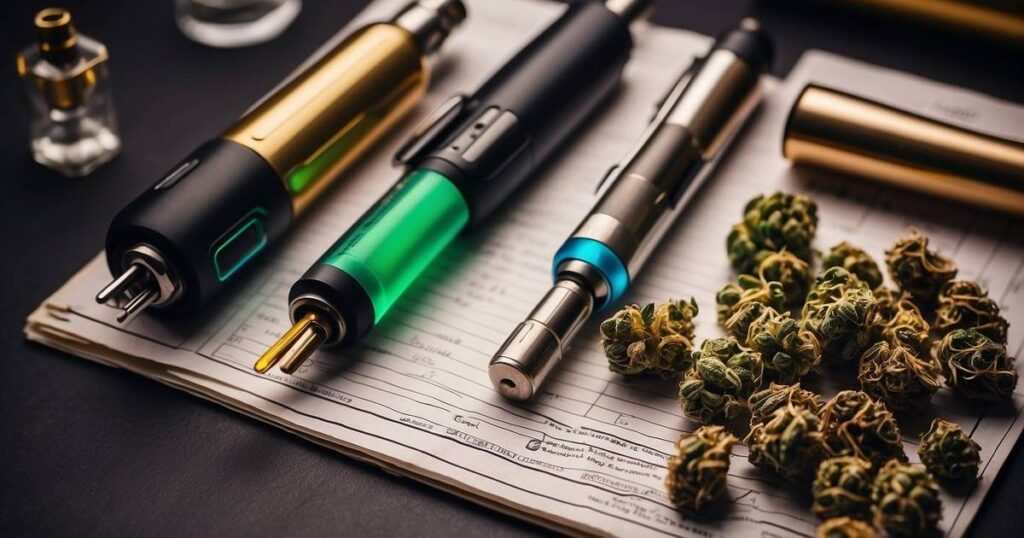Science Behind Disposable Cannabis Vapes: Understanding Their Function and Design
The science of disposable cannabis vapes lies in the intricate technology that enables the transformation of concentrated cannabis into an inhalable vapor. Designers create these devices for ease and portability, offering a convenient option to experience the active compounds in cannabis without the complexity of traditional methods. At their core, disposable cannabis vapes heat cannabis oil at a controlled temperature, which is crucial for avoiding combustion and producing a clean vapor.
Understanding how cannabis vapes work extends to the concept of heating elements within the pens. These elements gently warm the oil until it reaches the vaporization point, releasing the cannabinoids and terpenes as a breathable mist. Furthermore, this technology eliminates the need for combustion, commonly associated with the traditional smoking of cannabis, reducing the presence of harmful byproducts. As the name suggests, manufacturers pre-fill disposable vapes with cannabis concentrate and design them for discarding after depleting the contents, embodying a use-and-dispose ethos that prioritizes convenience.
Key Takeaways
- Disposable cannabis vapes heat oil to release cannabinoids and terpenes.
- They offer a combustion-free alternative to traditional smoking.
- Designed to be user-friendly and convenient, disposables are pre-filled and intended for one-time use.
Understanding Cannabis Vapes and Vaping Technology
In exploring the science of disposable cannabis vapes, it’s essential to understand the components, the vaporization process, and how vaping compares with other cannabis consumption methods.
Components of Disposable Cannabis Vape Pens
Your disposable cannabis vape pen is a compact device with several key elements. Each pen has an integrated battery that provides power to the atomizer, a heating element that turns the cannabis oil into vapor. Also, the vape pen’s mouthpiece is where you draw the vapor into your lungs. Here’s a brief overview of the parts:
- Battery: The power source for heating, usually rechargeable in non-disposable pens.
- Atomizer: Converts liquid to vapor through heating.
- Cannabis Oil: Contains cannabinoids like THC and CBD, often suspended in e-liquids.
- Mouthpiece: The channel through which the vapor is inhaled.
The Vaporization Process
The scientific principle behind the functioning of cannabis vape pens is the vaporization of cannabinoids at lower temperatures than combustion. When you activate your pen, the battery heats the atomizer. The atomizer then gently warms the cannabis oil containing THC and CBD to the point of vaporization, releasing the active compounds as a clean vapor. Also, this method preserves the cannabinoids and terpenes, providing a flavor-rich experience without the smoke produced from burning.
- Vaporization occurs at approximately 320°F to 356°F, below the point of combustion.
- Temperature control is key for maximum efficiency and preserving the quality of the vapor.
Compared to Other Consumption Methods
Vaping cannabis through your disposable pen provides a different experience compared to traditional methods like joints, edibles, or dabbing. Here’s a comparison:
- Smoke vs. Vapor: Vaping is considered more efficient in cannabinoid delivery because it produces vapor, not smoke, which can be less harsh on your lungs.
- Onset of Effects: Vaping can offer quicker effects than edibles, which must be digested and metabolized before you feel the impact.
- Portability and Discretion: Unlike dabbing or smoking joints, disposable vape pens are designed for stealth and convenience.
- Efficiency: You get more control over your dosage with vaping, which can lead to a more efficient use of your cannabis extracts without the loss of cannabinoids that occurs when smoking.
Understanding how cannabis vapes work enhances your ability to choose the right product for your needs while appreciating the technology that makes it possible.
Health Risks and Safety Regulations
The use of disposable cannabis vapes has grown, and with this rise, it’s important to understand the health risks and the regulatory environment that oversees their safety. Moreover, from the science of how cannabis vapes work to the complexities of chemistry and contaminants, let’s explore these crucial areas.
Potential Health Risks and EVALI
You might already know that vaping cannabis involves inhaling aerosolized compounds, but the concern lies in what else travels with THC and CBD. Vaping, specifically using e-cigarette or vaping products, causes EVALI (e-cigarette or vaping product use-associated lung injury), a serious health condition with symptoms including cough, chest pain, and shortness of breath. In addition, the CDC identified vitamin E acetate, an additive in some THC-containing vaping products, as a notable chemical of concern connected to EVALI. Toxins and other harmful substances found in vape products can lead to:
- Inflammation: This can cause lung damage and respiratory issues.
- Toxicity: Exposure to carcinogens and volatile organic compounds (VOCs) leads to an increased risk for cancer and other health issues.
Safety and Regulatory Considerations
Regulators, such as the FDA and Health Canada, are tasked with ensuring the safety of vaping products. Your consumer safety is at the heart of these regulations:
- Quality Control: Ensuring that products meet a standard for THC content and purity, with specific regulations around the percentage of THC and CBD.
- Permitted Additives: Regulating what additives, like terpenes and flavoring chemicals, can be safely used.
Manufacturers must comply with these regulations to guarantee product safety and prevent consumer harm.
Chemistry and Contaminants
Recognize the sophisticated chemistry of disposable cannabis vapes. When you activate a vape, the device heats a liquid containing cannabinoids like THC and CBD, turning it into an inhalable vapor. The concerns in the science of disposable cannabis vapes often revolve around:
- Additives: Including thinning agents and flavors, which, when heated, might produce toxins.
- Toxins: Metals from the vape hardware, such as lead or silica particles, can leach into the vapor you inhale.
- Contaminants: The presence of pesticides or residual solvents from the extraction process in the vape liquid can pose severe health risks.
As a user, you should consult a medical professional before using vape products for medicinal purposes and purchase only from reputable sources to ensure the safety and regulation of the cannabis vapes you consume.
Frequently Asked Questions
This section explores the science of disposable cannabis vapes and how they work, addressing commonly raised concerns.
What potential health risks does vaping cannabis pose?
When you vape cannabis, you expose yourself to fewer combustive byproducts than you do when smoking, but it is not without risk. Exposure to high temperatures can degrade the cannabis oil, potentially releasing harmful chemicals into your lungs. Poorly made heating elements in some disposables may amplify these risks.
How does vaporizing flowers compare to other methods of cannabis consumption in terms of health?
Vaporizing flower tends to be healthier than smoking since it reduces your intake of tar and carcinogens. The vapor you inhale from a flower vape is also cooler and may be less irritating to your respiratory system than smoke.
Can excessive use of cannabis vapes lead to negative side effects?
Yes, excessive use of cannabis vapes can contribute to side effects such as throat irritation, dry mouth, and, in some cases, more severe symptoms if the vape overheats or uses low-quality materials. It’s crucial to monitor your consumption and give your body time to process the THC.
What are the features and functions of adjustable color settings on cannabis vape pens?
Adjustable color settings on cannabis vape pens typically indicate temperature control. Additionally, different settings can affect the potency and smoothness of vapor, with lower temperatures producing milder effects and higher settings generating thicker vapor with more robust effects.
Among different types of cannabis vapes, which ones are known to be most potent?
The potency of cannabis vapes comes from the concentration of THC in the oil. Vapes using highly concentrated cannabis oil or distillates tend to be more potent than those that use standard oil.
What are the correct methods for charging a disposable cannabis vape pen?
Since disposable cannabis vape pens are meant to be used until the oil or battery runs out, there is generally no need to charge them. They come pre-charged, and you dispose of them responsibly after use. Always follow the manufacturer’s instructions for proper use and disposal.





